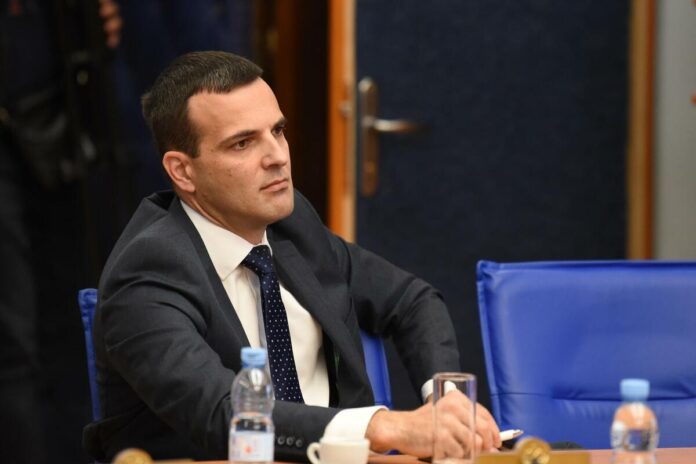Duklja Culture in the Late 12th and Early 13th Century
The Democratic Party of Socialists (DPS) has presented a text authored by its member, historian Dragutin Papović, titled “Duklja Culture at the End of the 12th and Beginning of the 13th Century.”
We provide the full text below:
By the end of the 12th century, Grand Prefect Stefan Nemanja had incorporated Duklja into Serbia (Raška) through military conquest and the destruction of its cities. As historian Sima Ćirković notes, it remained uncertain during this period whether Nemanja’s state would endure, as it was not a centralized entity but a collection of principalities deeply rooted in age-old political traditions. Duklja, in particular, exhibited distinct political, religious, ethnic, and cultural traits compared to Serbia, which can be seen in its literacy, literature, painting, and architecture.
Literary historian Dimitrije Bogdanović highlighted that the Chronicle (Kingdom of the Slavs) by the Priest of Dukljanin, the primary Dukljan manuscript from the 12th century, aligns more with Latin chronicles and medieval historiography than with early Serbian literature, which emerged from the Macedonian-Glagolitic tradition. Bogdanović asserted that the Chronicle is “entirely distinct from the mainstream of medieval Serbian historiography and hagiography” in its literary characteristics and ideological content. This chronicle stands as a foundational work in Montenegrin literature and historiography, as literary scholar Danilo Radojević suggested, representing a “spiritual link to the early Middle Ages of Montenegro.”
Cyrillic writings in Duklja were also shaped by Latin literary traditions and artistic influence. The most significant preserved Cyrillic text from this era is the Gospel of Miroslav, dating from the late 1180s, created for “Prince Miroslav, son of Zavidin,” brother to Stefan Nemanja. Miroslav ruled over Hum during the 1180s. The majority of the text was inscribed by an anonymous scribe using Zeta-Hum (also known as Duklja) orthography, influenced by the Beneventan angular script. In contrast, a smaller section was penned by a student of Gl(r)igorija in the Raša orthography, shaped by Russian script traditions. Although the entire manuscript is in Cyrillic, these orthographies exhibit a clear divergence. The Zeta-Hum orthography draws on earlier Glagolitic Romanesque texts from coastal regions, while the Raša orthography is modeled after Russian literary works. Historian Tomislav Raukar posited that the Cyrillic script spread from Bulgaria and Macedonia to Serbia, Duklja, Hum, Bosnia, and Croatia in the late 12th and early 13th centuries. Interestingly, the earliest preserved Croatian Cyrillic text, “Povaljski prag,” from Brač, was created in 1100, nearly contemporaneously with Miroslav’s Gospel. Cyrillic literacy developed in Croatia, Duklja, Hum, and Bosnia, creating a distinctive Western Cyrillic area that, according to Raukar, differed graphically and linguistically from its Eastern Orthodox counterpart.
The Gospel of Miroslav was produced outside of Byzantine and Orthodox influence, arising purely from Latin literary and religious traditions. This is evident in the illuminations (miniatures) within the text, which, as art historian Pavle Mijović noted, showcase a blend of late Attic, Byzantine, and Italic fine art. Mijović observed that the miniatures reflect the spirit of early Romanesque and Western miniature art, surpassing all prior Slavic illustrated works in artistic quality and detail. He claimed that “the Gospel of Miroslav stands uniquely as a monument within the complex artistic tradition conceived in Duklja under exceptionally intricate circumstances.” Beyond their Romanesque inspirations, these miniatures primarily illustrate local artistic expression, signaling the emergence of a “young feudal culture” during Duklja’s early history. Mijović traced this artistic influence back to the collaboration of Byzantine Basilians (Orthodox monks) and Latin Benedictines from southern Italy (Apulia and Campania), suggesting that the original designs for the initials in the Miroslav Gospel were derived from Benedictine centers in Capua and Bobbio. He contended that the Gospel was not created or illuminated within the church of St. Peter in Bijelo Polje, but rather in a secular setting, likely a scriptorium in one of Duklja’s coastal towns. Art historian Vojislav J. Đurić mentions that nearly three hundred miniatures in this gospel exhibit the work of a single painter, featuring “Western elements.” He emphasized that the dimensions and arrangements of the initials align with Latin texts and that the initial letters incorporate characteristics typical of Romanesque miniatures from Rome, Tuscany, and southern Italy. Based on these features, Đurić concluded that Miroslav’s Gospel emerged as a prime example of Zeta decoration in books.
The Nemanjić dynasty also encountered distinct architectural styles and applied arts within the Duklja state. Art historian Vojislav Korać stated that the architecture of Duklja developed in the late 12th and early 13th centuries, influenced by Western European designs, particularly from neighboring Italian regions. Politically and religiously, Duklja (Zeta) integrated into the Western European landscape. While Duklja boasted a rich architectural heritage stemming from advanced coastal cities influenced by Byzantine and Western cultures, Serbia was characterized by architectural simplicity and asceticism. Korać concluded that the structures built during Stefan Nemanja’s era at Đurđeva stupovi near Novi Pazar potentially utilized the same artisans responsible for the Cathedral of St. Tryphon in Kotor. It is clear that Serbian rulers enlisted Duklja (Zeta) craftsmen for their constructions in Montenegro, adopting elements of Romanesque architecture in churches such as St. Peter in Bijelo Polje, St. George (Đurđevi stupovi) in Berane, and the Assumption of the Blessed Virgin Mary in Morača (Morački Monastery), which were adapted from Zeta Romanesque designs.
Korać noted that the church of St. Peter in Bijelo Polje diverged from the earliest Raška churches, having been modified to align with Raška architecture. Art historian Jovanka Maksimović suggested that remnants of pre-Romanesque sculptural stone decoration found in St. Peter’s church point to a renovation or expansion carried out by Prince Miroslav, with the church dating back to between 1190 and 1195. Art historian Tomislav Marasović remarked on its typological similarity to St. Nicholas church (Mikula) in Veli Varoš, Split, built during the late 1190s and early 1200s. Although renovations were likely funded by Prince Miroslav around 1200, there is a possibility these enhancements were finalized posthumously, between 1200 and 1202. Vojislav J. Đurić asserted that the architectural design of St. Peter’s Church follows Romanesque basilicas and cathedrals in the West, constructed by coastal artisans. Its monumental portal adorned with the founder’s inscription, square dome, and rectangular apse were designed in the styles of Dalmatian pre-Romanesque and Romanesque churches, while the overall cruciform layout reflects Byzantine influences. The presence of dual towers with a narthex showcases features typical of Raška architecture while also resembling those found in the Cathedral of St. Tryphon in Kotor. Thus, the original dedicated rite of St. Peter’s Church, whether Catholic or Orthodox, remains a matter of debate. Historian Mladen Ančić noted the ambiguity surrounding Prince Miroslav’s affiliation with either confession. Since the mid-13th century, this church has served as the seat of the Hum Episcopate. Consequently, American Byzantologist John V.A. Fine (Jr.) concluded that the Church of St. Peter with Bijelo Polje and Lim marked the boundary between Hum and Serbia. This church likely dates back to the Duklja period, along with the Church of the Nativity of the Blessed Virgin Mary (Bogorodica Bistrička) in the Voljavac Monastery, situated along the right bank of the Lim River, near today’s Montenegro-Serbia border. Traditionally, King Mihailo Vojislavljević was credited with its construction, and it bears similarities to the church built by Mihailo in Ston on the Pelješac peninsula.
The Church of St. George (Đurđeve stupove), located near Berane, was established by Prefect Prvoslav, son of Tihomir, who fell in battle against his younger brother Stefan Nemanja in 1168. The construction of Prvoslav’s church dates back to 1213. Vojislav J. Đurić remarked that the original single-nave church with a dome shows closer resemblance to Kotor’s Romanesque churches of St. Luke and St. Mary than to Raška’s churches. Later expansions introduced elements characteristic of Raška architecture. The plan for the Church of the Assumption of the Blessed Virgin Mary in Morača, constructed between 1251 and 1252 by Stefan, son of Vukan, reveals Raška architectural traits, modeled after the church at Žiča Monastery, while the windows showcasing stone decorative elements exhibit Romanesque styling. The sculptural details of the western portal reflect Italian Romanesque influences, whereas the granite episcopal throne represents the only known example in Montenegro, echoing episcopal thrones from southern Italy in both form and ornamentation. Additionally, elements of folk art are present in the Morača sculpture.
Despite Duklja being annexed into the Nemanjić state by the end of the 12th century, its unique cultural, ethnic, and religious characteristics continued to evolve independently. Most notably, the cultural achievements of Duklja were significantly more advanced than those of Serbia, to the extent that Serbian rulers began emulating Duklja’s literary, artistic, and architectural standards.
News


